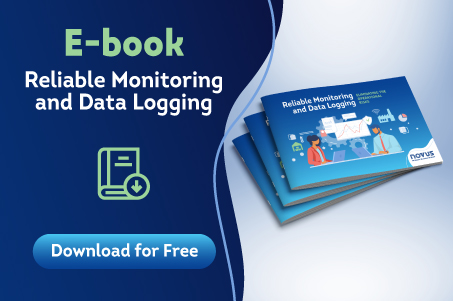Now that you know that using Arduino in industry is a reality, it’s time to overcome new barriers! Watch the videos.
The technological evolution is increasingly faster and innovating is a must for every company. But more than innovating, it is necessary to be disruptive. You already know DigiRail NXprog , the NOVUS Arduino programmable CPU I / O platform. With DigiRail NXprog and our videos we show that Arduino in the industry is not only a trend but a certainty. And like any technology that breaks down barriers, the users themselves are the ones who develop the new possibilities.
Now check out some videos of complex applications and download the codes so that you can see that with Arduino, even the most sophisticated applications are possible!
RHT Climate Reading by Modbus RTU
This example demonstrates a temperature and relative humidity transmitter reading by Modbus RTU through DigiRail NXprog.
Using the DigiRail NXprog’s native RS485, it is possible to read Modbus RTU slave registers.
In this way, it was possible to read RHT Climate Temperature, Relative Humidity and Dew Point, and display this information on the IDE Arduino console.
Click here to download the code.
RHT Climate writing by Modbus RTU
This example demonstrates commands on the RHT Climate transmitter writing through DigiRail NXprog by Modbus RTU, using the value forcing commands available on the temperature and relative humidity transmitter. It was possible to force a relative humidity value that was visible on the RHT Climate display demonstrating that it is possible to write on Modbus RTU slaves through DigiRail NXprog.
Click here to download the code.
ON/OFF Control
This example demonstrates ON / OFF control in a lamp heating process. In a simplified way, the example shows the activation and deactivation of the power of an incandescent lamp by switching the relay output of the DigiRail NXprog. Then, when the temperature measured by the Pt100 sensor is below the setpoint, the lamp is on and when the setpoint temperature is reached, the lamp turns off and is activated again only when the hysteresis is exceeded and keeping the temperature around the setpoint when turning the lamp on and off.
Click here to download the code.
PID Control
This example demonstrates PID control in a lamp heating process. In a simplified way, the example shows the activation and deactivation of the power of an incandescent lamp by switching the relay output of the DigiRail NXprog. Thus, when the temperature measured by the Pt100 sensor is below the setpoint, the lamp is on and when the temperature approaches the setpoint, the relay switching respects the frequency established by the PWM, leaving part of the time activated and part of the time disabled. After a few minutes of the process running, the temperature band around the setpoint is very narrow, eliminating virtually all overshoot.
Click here to download the code.
Modbus TCP Reading and Writing
This example demonstrates the reading and writing of the DigiRail NXprog by Modbus TCP, using the region of the register table from 400 to 499, which is the region accessible by both the Arduino application and the I / Os. For this demonstration, serial communication software was used to access register 400 and 401 by Modbus TCP / IP. So that when writing some value in register 400, it is displayed by the serial monitor that is reading the DigiRail NXprog registers and register 401 is a counter of the number of entries in register 400, which increases with each entry.
Click here to download the code.
Data Logger
This example demonstrates the implementation of a simplified Data Logger, which records the data of the DigiRail NXprog and makes this data available through the serial monitor. Some advanced functions are used for this example, such as RTC with NVRAM, to store the last timestamp logged in case of power loss; and the memory functions of the EEPROM library. Some commands were implemented for the operation of the Data Logger, they are: START, to start the records; STOP, to stop the records; CLR, to clear the memory; and DUMP, to display the entire contents of the serial monitor memory.
Click here to download the code.
















